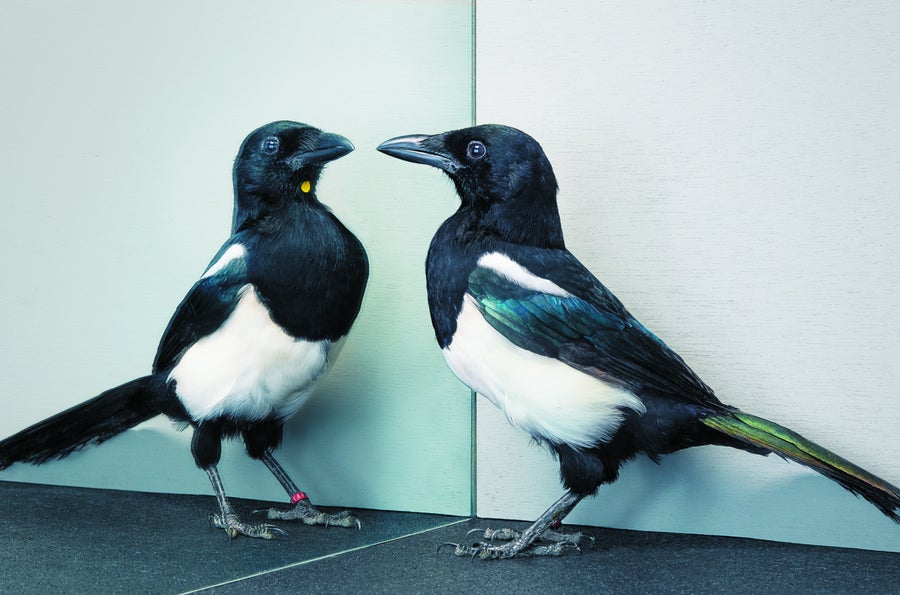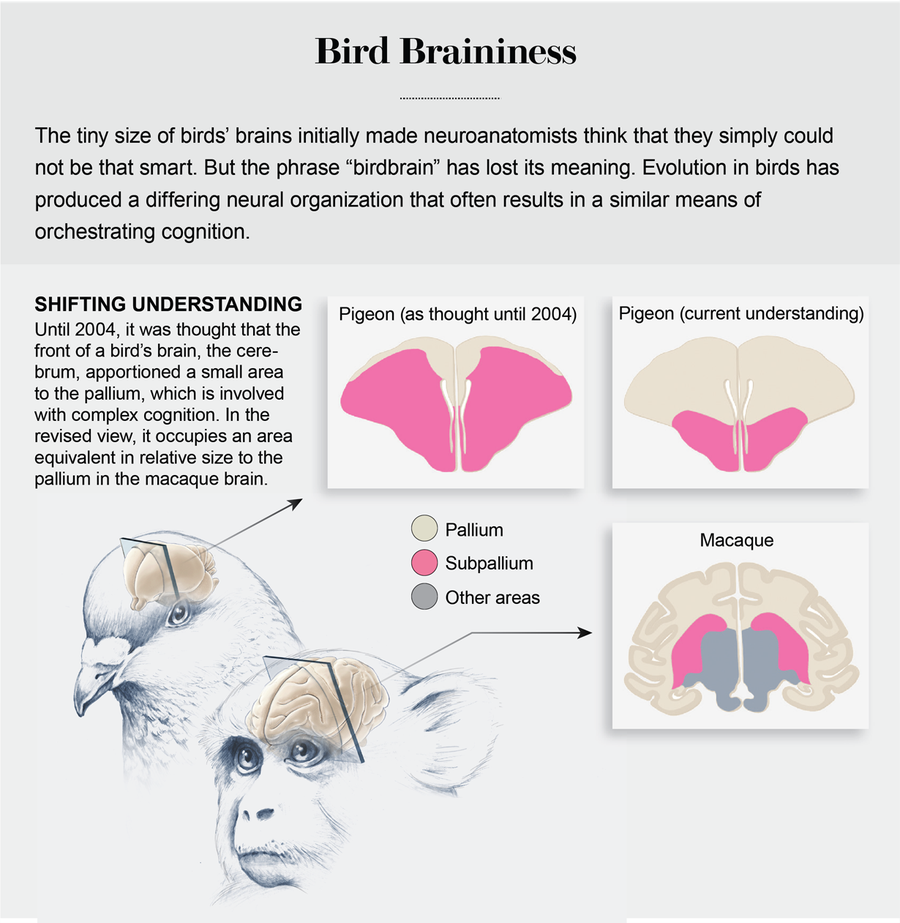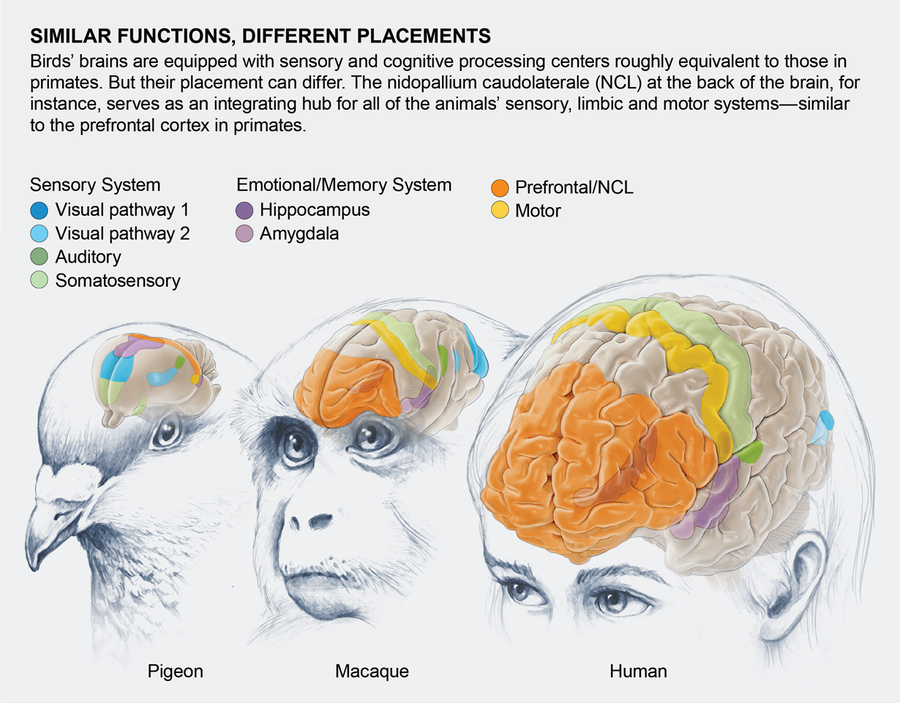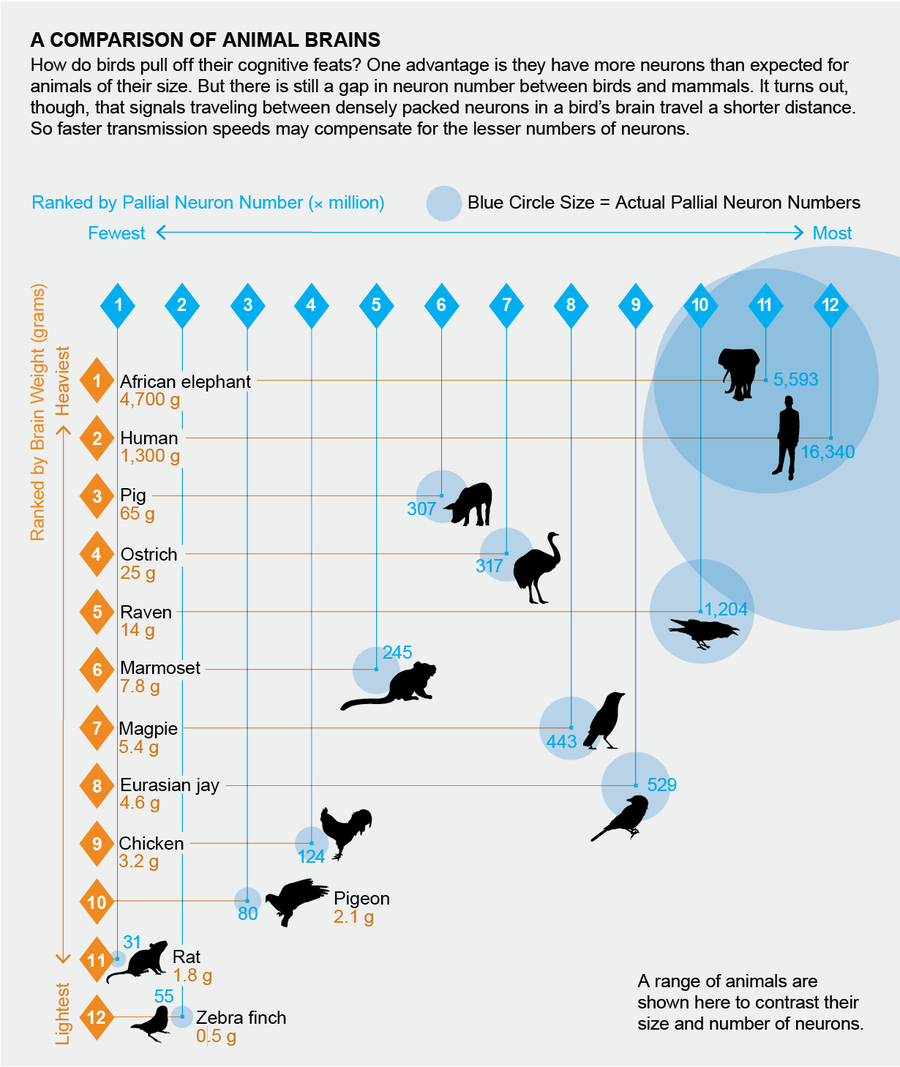In my laboratory at Ruhr University Bochum in Germany, my colleagues and I took Gerti, a Eurasian magpie, out of her home cage, covered her head with a cloth, and placed a small yellow paper sticker on the black plumage of her throat, which she could not see. Then we placed her into a test cage with a large mirror, left her alone and went to the neighboring room to observe her through a monitor. Gerti first looked into the mirror and immediately tried to vigorously remove the sticker by scratching her throat or rubbing it on the floor. Once she did, she took a final look into the mirror to calm herself down. In apes, such behavior is taken as evidence for self-recognition. Never before had this been observed in a bird.
We were all excited that day in 2006, but we also had to ask the obvious question: What if we were wrong? Couldn’t it be that Gerti removed the mark simply because she had felt something on her throat? Our team at Bochum, including Helmut Prior, Ariane Schwarz and me, further tested Gerti under identical conditions, except that the magpie had a black sticker that was hardly visible on her black plumage. In still other control conditions, we marked her with a yellow sticker but did not provide a mirror. In all these instances, Gerti did not attempt to remove the marks. The sticker-extracting behavior occurred only when the bird could see a salient mark on her plumage in the mirror. Because several other magpies we tested behaved in a similar fashion, we concluded that Eurasian magpies seemed to understand that they were seeing their own reflection in the mirror.
Other than humans, only a few mammals with large brains such as chimpanzees, orangutans, Indian elephants and bottlenose dolphins had at the time demonstrated similar evidence for self-recognition. The ability of magpies to recognize themselves in the mirror is just one of many aspects of complex cognition that have recently been demonstrated in corvids and parrots. These new discoveries shake the dominant, century-old theory that such skills require the presence of a large cortex, the forebrain’s outer layer. Because birds have no cortex, they should not excel in self-recognition or other cognitive tests. Investigations of avian cognition in the past two decades have indicated how vastly different brain physiology in birds and humans can, over the course of hundreds of millions of years, result in astonishingly similar cognitive faculties that form the basis for high-level learning, self-awareness and decision-making.
On supporting science journalism
If you're enjoying this article, consider supporting our award-winning journalism by subscribing. By purchasing a subscription you are helping to ensure the future of impactful stories about the discoveries and ideas shaping our world today.
Varieties of Cognitive Evolution
To understand why biologists thought birds lacked these skills, we have to go back to the neuroanatomical lab of Ludwig Edinger of Goethe University Frankfurt in Germany at the end of the 19th century. Edinger, who lived from 1855 to 1918, devoted his scientific life to revealing how brains and minds of vertebrates evolved. He was confident that evolution unfolds in a step-by-step path from primitive to complex—advancing from fish on to amphibians, reptiles, birds and mammals. He discovered that the most basic brain components had always existed in vertebrates.

EURASIAN MAGPIE inspects its own image in a mock-up of a self-recognition experiment. Credit: Tim Flach
But a large region of the brain called the cerebrum seemed to have undergone major evolutionary changes that were possibly the reason for the expansion of cognitive abilities. The cerebrum consists of two main parts: the uppermost pallium (Latin for “mantle”) and the underlying subpallium. The mammalian pallium is mostly made up of the six-layered cortex—the main seat of mammalian cognition—but also contains smaller parts such as the amygdala and the hippocampus. In contrast, the subpallium looks like a homogeneous lump of neurons that stores and later activates learned movement patterns. The situation in birds is radically different. When working within the anatomical scheme set out by Edinger, an observer finds the pallium strongly resembles the subpallium. As a result, Edinger mistook most of it for the subpallium. Consequently, he concluded that birds have a huge subpallium but only a small pallium, and so their cognitive abilities should be very limited.
What a mistake! Edinger was a towering scientist of his time, and his theory appeared to explain convincingly why we mammals excel in cognition. For that reason, his fallacious theory persisted for more than a century and deeply influenced neuroscientific thinking up to the dawn of the 21st century.
There was another reason that birds’ brains were considered to be inferior. Avian and mammalian brains differ also in terms of size. Ostriches have the largest brain among birds, weighing in at 25 grams. In contrast, a chimpanzee brain is about 400 grams, that of a human is 1,300 grams, and a sperm whale brain weighs a whopping 9,000 grams. At least among primates, brain size correlates with cognitive abilities. Thus, because of both the lack of a large cortical pallium and the presence of their small brains, birds were thought to have severely limited cognition. But how then is it possible that Gerti the magpie was able to pass the mark-and-mirror test, leaving most large-brained mammals behind? Either birds are not that smart, or something is wrong with our century-old view on the need for a large cortex for cognition.
The Crows of New Caledonia
Some perspective can be found by considering New Caledonian crows from the South Pacific, which mostly live on grubs that they retrieve from crevices in the barks of trees. In 1996 Gavin Hunt, then at Massey University in New Zealand, reported that New Caledonian crows manufacture two different tool types with which they capture their prey. The process of making these tools is so complex that Hunt compared it with stone-tool production of Middle Paleolithic humans, who lived from 300,000 to 40,000 years ago.
Several animal species seem to engage in tool use, but when properly tested, much of this behavior turns out to be based on innate programmed sequences of responses, not on cognitive evaluation of a problem. Alex H. Taylor of the University of Auckland in New Zealand and Russell Gray of the Max Planck Institute for the Science of Human History in Jena, Germany, embarked on studies to properly understand the mental basis of tool use in New Caledonian crows. These experiments demonstrated that the crows can solve diverse problems by reasoning about underlying causal relationships. They plan ahead using mental representations of unseen objects and make inferences about cause-and-effect relationships of observed events.
The crows’ understanding of the physics of their actions, however, does have certain limits. Although they infer the weight of objects from the way they sway in the wind, they sometimes fail to understand that heavy objects have more impact on the surface on which they fall. Overall, New Caledonian crows show outstanding prowess in most but not all aspects of physical cognition.
How about social cognition? The crows can work within a team but do not understand that their partners can collaborate on a task to become, in effect, a “social tool” that assists in better accomplishing a goal. They look at objects that others manipulate but miss critical details of the other birds’ behavior in comprehending the relevant action sequences. Instead they seem to visualize how a tool works and then reverse engineer it from memory rather than learning directly from others. Although the crows evolved extraordinary physical cognition, the same did not occur for mental activities involving their social interactions. Is such a limitation specific for New Caledonian crows, or does it also apply to other birds? An answer comes from examining ravens.

Credit: Mesa Schumacher

Credit: Mesa Schumacher

Credit: MSJONESNYC
Raven Politics
Young ravens that do not have a bonding partner or territory form temporary flocks that congregate at major food resources, such as an animal carcass. When large predators defend their food caches, ravens call in other flock members to engage in diversionary tactics for gaining access to the food. To prevent pilfering, they also implement devious strategies to stop other birds from observing their food stores. Likewise, ravens observe other birds to steal any unattended caches. Breeding pairs also defend a territory against other ravens. During such fights, mates as well as nonbreeders with developed social networks have considerably higher chances to win competitions and save their food caches. Thomas Bugnyar of the University of Vienna in Austria, Bernd Heinrich of the University of Vermont and their collaborators have been leaders in studies showing that ravens demonstrate these highly developed social strategies.
A prerequisite for all such activities is an ability to intuit the networks to which other birds belong—and the intentions of any individual that might be encountered in their daily wanderings. Ravens stay alert for calls that indicate when a dominance rank reversal might have occurred. They also use their knowledge about social networks when under attack from a dominant raven. When their own kin are nearby, they try to alert them by issuing repeated distress calls, but they stay more silent when the bonding partner of the attacking bird is close. Because rank in a dominance hierarchy increases after bonding, birds track the bonding of others and intervene aggressively to disrupt their pairings. By doing this, they are likely to prevent others from forming new bonds and to keep competing birds from increasing in rank.
Social competence is also needed in other settings. A raven will track when it is being observed and another bird could have spied its cache. Ravens seem to understand what others can or cannot see and even assess another bird’s level of knowledge—an attribute of what is called theory of mind. If necessary, ravens deceive potential cache thieves by leading them to an empty place where they pretend to have food stockpiled.
These social skills are complemented by a high degree of self-control and a solid understanding of when to use force in their dealings with other animals and alternatively when to back off. Can Kabadayi and Mathias Osvath, both at Lund University in Sweden, showed that ravens are able to plan for different kinds of future events. The birds opt to choose a tool, such as a stone, over an immediately available small reward. With these implements, they can obtain a larger reward the next day by either bartering or using the tool to directly obtain some benefit. Ravens, in sum, combine all aspects of complex cognition in a brain of just 14 grams.
Of Parrots and Pigeons
Ravens and New Caledonian crows are just two examples of cognitively capable corvid species. Nicola Clayton of the University of Cambridge has shown in two decades of research that scrub jays excel in all aspects of complex cognition. Most important, these birds were the first nonhuman animals in which episodic memory could be demonstrated. Episodic memory allows an animal to recall past life events and to imagine future undertakings.
Some parrot species, in fact, can attain feats equal to those of nonhuman primates. Recall Alex, the legendary grey parrot. Irene Pepperberg of Harvard University, who along with Clayton pioneered studies on cognition in parrots and corvids, demonstrated Alex’s skills in categorizing various objects, actions and numerical quantities up to eight. The researchers also confirmed Alex’s understanding of concepts of relative size, his discerning of when an object was absent, and his ability to detect similarities and differences in an object’s individual attributes. Alex could even engage in simple addition by applying a zerolike concept in numerical tasks.
.jpg?w=900)
BIRD SMARTS: A grey parrot succumbs to an illusion (2), a raven wields a tool (3) and a scrub jay shows off its memory skills (1). Credit: Arlene Levin-Rowe and the Alex Foundation (2); Helena Osvath (3); Nicola Clayton (1)
As impressive as these studies are, primatologists have raised the question of whether these birds might be clever in only a few highly circumscribed cognitive domains compared with the broader reach of primate cognition. If that were true, corvids and parrots should fail when tested with a wide diversity of tasks. To explore this question, Bugnyar and I looked for studies on assorted types of cognition in nonhuman primates and for similar research on corvids and parrots. After having collected all such available publications in eight areas of complex cognition, we concluded that corvid and parrot cognition is on par, both in magnitude and in breadth, with that of nonhuman primates.
Corvids and parrots are known to be smart birds. But what about other birds such as pigeons? While European magpies, ravens and New Caledonian crows have brain weights of about 5.5, eight and 14 grams, respectively, pigeons’ brains weigh in at about two grams—comparable to the weight of a rat’s brain. But even pigeons are brainier than assumed. Lorenzo von Fersen and Juan Delius, then both at Bochum, demonstrated that pigeons can memorize 725 abstract patterns and use transitive inference logic. (An example: You can deduce that Jennifer is taller than Sarah if it is known that Jennifer is taller than Sonia and Sonia is taller than Sarah.)
Recently Damian Scarf and Mike Colombo, both at the University of Otago in New Zealand, and I, with other colleagues, showed that pigeons learned to distinguish between four-letter English words and nonwords, which were composed of combinations of one vowel and three consonants. Pigeons mastered that task and transferred their knowledge to new sets of words and nonwords by using spelling strategies akin to those practiced by primary school pupils. Overall, pigeons can achieve cognitive performances on these tasks similar to those of corvids and parrots in some but not all tasks. Even when successful, they need much longer to learn a task and require more training to grasp an abstract rule. Not all birds are as clever as a crow or a parrot. But they are brainier than once thought.
Credit: Tim Flach
When birds succeed in managing such diverse cognitive tasks using a small brain without a cortex, they find a way to compensate for these limitations. In fact, beginning in the 1960s, Harvey Karten, now at the University of California, San Diego, used new methods to begin a series of studies that demonstrated that most of what Edinger coined the subpallium in birds must instead be the pallium. He went on to show that the sensory and motor pathways that connect the avian pallium to other brain areas were identical to those of the mammalian cortex. In 2002 an international consortium of neuroscientists reviewed all accumulated evidence and concluded that birds indeed have a much larger pallium than previously assumed. In addition, the avian pallium is similar to that of mammals and shares common ancestry with the mammalian one.
The mammalian pallium is not all cortex and includes other areas such as the hippocampus or parts of the amygdala. How much of the bird pallium is like the cortex is still subject to debate. Whereas some researchers are confident that most of the bird pallium is similar to some cortical layers or cell types, others contend that most of it is only analogous to the amygdala and other noncortical pallial areas. It is important to emphasize that dissimilar brain structures of two groups of animals can perform identical functions through an evolutionary process called convergent evolution. The prefrontal area is a perfect example. The mammalian prefrontal cortex (PFC) plays a key role in all aspects of complex cognition.
In the beginning of the 1980s Jesper Mogensen and Ivan Divac of the University of Copenhagen in Denmark reported that an area of the posterior pigeon pallium resembled the mammalian PFC. Because this was a first clue to the neural basis of bird cognition, I started a still ongoing series of studies in which we could indeed show that this area—the nidopallium caudolaterale (NCL)—is, like the PFC, a zone of encounter between incoming sensory inputs and outgoing commands to the motor system to initiate an action. As in the PFC, the NCL also plays a critical part in all cognitive tasks, and its neurons encode cognitive functions such as decision-making, adherence to rules devised for the experiments, and the assigning of values to various options before a choice is made.
Although the NCL and PFC are highly similar, genetic evidence and their locations in the most posterior and most anterior parts of the pallium, respectively, make it unlikely that these two areas stem from a common precursor of birds and mammals. Instead they possibly once had quite different functions in early precursors of mammals and birds but converged over the course of 300 million years into areas dedicated to cognitive integration of sensory inputs with motor outputs. During our research, I often thought of the famous phrase of Dr. Ian Malcolm in Jurassic Park: “Life finds a way.” If two unlike animal groups both desperately need a brain area that orchestrates cognition, they both independently evolve a prefrontal area.
To explore how distinctive physiology can end up furnishing the same cognitive function, Murray Shanahan of Imperial College London and I, along with other colleagues, looked at how the connectome, or brain wiring diagram, of the pigeon pallium is organized. Because the bird pallium seems to be so different from the cortex, we also expected a different connectivity pattern. After reconstructing the pigeons’ connectome, we had our aha moment: the avian pallial networks—with different areas dedicated to distinctive functions—were astonishingly similar to that of mammals. Our take-home message was simple: if two groups of animals develop similar mental functions during evolution, they also develop the same blueprints of connectivity because similar mental functions seem to require similar networks.
A major puzzle still remained. How do birds manage to come up with all their cognitive power given the small size of their brains? To find an answer to this question, Seweryn Olkowicz and Pavel Nemec, both at Charles University in Prague, Czech Republic, and Suzana Herculano-Houzel, now at Vanderbilt University, along with other colleagues, estimated the neuron numbers of 28 avian species. They were amazed to discover that corvid and parrot brains contain twice as many neurons as expected for their brain size. Because these “surplus” neurons are mostly located in the pallium, corvids and parrots have more computing power than some monkeys with larger brains.
Even if birds have more neurons than expected, the extremely small size of their brains means there still remains a gap between the neuron numbers of birds and mammals that are cognitively on a par. For example, keas (a type of parrot found in New Zealand) have 1.28 billion pallial neurons, ravens possess 1.2 billion and chimpanzees have 7.4 billion neurons, although research could not evince systematic cognitive differences among them.
How do birds compensate for the numerical gap? It turns out that a greater concentration of neurons results in the distances between avian neurons being shorter. In tasks in which information is repeatedly sent back and forth among groups of neurons in the densely packed cerebrum, a time gain may result as signals take less time to travel from one point to the next. Indeed, Sara Letzner and Christian Beste, both at TU Dresden in Germany, and I showed that pigeons can react faster than humans when working on a particular cognitive task. The density of neurons in the bird pallium compensates for some of the smaller neuron numbers by affording faster conduction speeds.
A New Look at Avian Cognition
When scientists across the globe started to discover the extraordinary cognitive abilities of birds, the derogative “birdbrain” lost its scientific rationale. Indeed, we now know that brains of birds and mammals are much more similar than previously thought.
Behind these discoveries, a deeper insight becomes visible. To comprehend it, we first have to realize that independent from each other, both birds and mammals spread throughout the globe by conquering nearly every ecological niche that can sustain a vertebrate. Both branches of the animal kingdom also became “generalist species” that are not bound to a narrow ecosystem but survive nearly everywhere. High cognitive capacities were needed to quickly find solutions to novel problems and to outsmart competitors. Thus, the strong selection pressure in both vertebrate classes produced very sophisticated cognitive abilities.
It is less of interest that both groups succeeded in growing smart. Rather this accomplishment came about through development of mostly identical neural mechanisms despite differently organized pallia. Birds and mammals cognitively thrived by increasing neuron numbers. Mammals did so by expanding brain size and birds by amplifying neuron density. They both developed substantially similar networks of pallial connections and evolved “prefrontal” areas with identical physiological, neurochemical and functional features. The same can be said for cognition itself. The way birds and mammals learn, remember, forget, err, generalize and make decisions follows identical principles. This astonishing degree of similarity is only possible when nature offers severely limited degrees of freedom in generating neural structures for complex cognition. Birds and mammals evolved similar neural mechanisms and ways of thinking—taking different paths that ended in the same place.
